October was a month that might have spooked many site owners with the recently launched October Spam Update, reflecting similar attitudes that were seen when the Helpful Content update was announced.
If the recent months reminded us of anything, it’s time to review your content and to see if you can resurrect zombie content back from the dead.
The regular traffic light system is in place to highlight which algorithm updates may need immediate attention, and which ones are less pressing:
- Red light updates are major changes that should be factored in straight away;
- Amber is for updates that you should take note of, but won’t need urgent action;
- Green updates are still worth knowing about, yet less critical than the others.
Keen to know more about any of these changes and what they mean for your SEO? Get in touch or visit our SEO agency page to find out how we can help.
In this post, we’ll explore:
- October 2022 Spam Update
- What was the impact?
- What does this mean for me?
- Google introduces site names for mobile results
- Google Webmaster Guidelines changed to Google Search Essentials
- What has changed?
- Google on the use of stock photography in relation to SEO
- SEO split testing: Matching the H1 with the title tag
- The test
- The findings
- Why is this important?
October 2022 Spam Update

Starting on October 19, and only taking less than 42 hours to complete, Google recently rolled out a new spam update. Spam updates roll out regularly and are designed to maintain the quality of search results, improving the automated systems that work in the background to detect spam results in the SERPs.
What was the impact?
When it comes to spam updates, Google states that it targets “sites that violate our policies” and that they “may rank lower in results or not appear in results at all.” Although, generally when spam updates roll out there isn’t much of an impact on higher quality websites, this spam update and the days following saw some increased ranking volatility.
On October 22nd, the day after the spam update, SEOs were reporting on social media that they had seen a decrease in rankings, and a few ranking tools highlighted a similar trend in visibility. Search Engine Roundtable suggested that Google was too quick to say that the update was over, or that there was an unconfirmed new update. Or, simply that the reporting tools were a day late in their reporting of the update, as shown below.
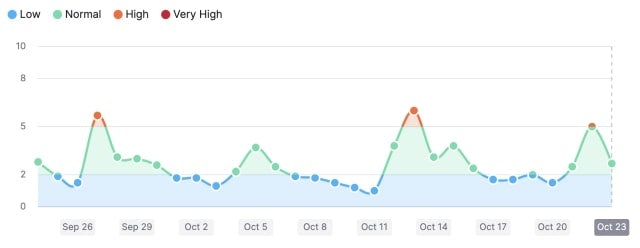
What does this mean for me?
If you’re following the guidelines written on Google Search Essentials (formerly known as Webmaster Guidelines), it’s likely that you won’t have to worry about the October spam update affecting your site. However if you are hit, Google has said it will likely take months to recover.
Typically being guilty of spam includes low-quality sites that trick users into providing personal information, installing malware or posing as other highly relevant pages. Although, thin content could be considered spam-like. If so, your site would’ve more likely have been hit by the Helpful Content update.
If you’re unsure what Google defines as spam, or if you were hit by this spam update and aren’t sure how to recover, it’s worth reviewing the new Google Search Essentials and Google’s spam policies.
Google introduces site names for mobile results

Google is introducing site names on mobile search results. This is in an effort to make it easier for searchers to identify the website that is associated with each result. These site names on mobile are currently available for results in English, French, Japanese, and German, however will be rolling out in additional languages over the next few months.
Site names on mobile results will appear on the search results as shown below.

To indicate your preferred site name to be shown on search results, you should use structured data (also known as schema) on your homepage. Google outlines how you can do this for your site in this helpful sitename page, where they also reiterate that content in title elements and heading elements, such as H1 elements are factors in specifying your sitename.
It’s important for site owners to have their chosen name in the results so that users can easily pick out the website at a glance. The name should be unique and concise so it can be commonly recognized. We’d also recommend that site owners revisit favicon documentation, as this has also recently updated and could impact how your site is seen in mobile search results.
Google Webmaster Guidelines changed to Google Search Essentials

In October Google rebranded Google Webmaster Guidelines to Google Search Essentials this wasn’t just a name change. The new name brought with it a host of new features and changes!
What has changed?
- Brought in a new overall format adding clearer terms and examples
- Simplified sections for easier consumption
- New section ‘Technical requirements’ addresses how to understand and publish content in a way that allows Google to index and access it effectively
- Updated guidance on ‘Spam policies’
- New guidance on ‘Key best practices’ to consider when creating a site and how content that serves people will help a site be found more easily in SERPS
- Consolidation of content on Thin content and Affiliate programs
- ‘Hacked content’ consolidates information previously in the security section
The changes overall seem to be quite minimal but it’s key to watch out for any other rebrands of Google’s services as they’re coming thick and fast at the moment.
Google on the use of stock photography in relation to SEO

Two members of the Google teams discussed the use of stock photography in the ‘Search Off the Record’ podcast. They explored the pros and cons of the practice and how it impacts SEO.
John Mueller of Google said using stock images as ‘decorative elements’ to your website is “perfectly fine” so adding a little bit of aesthetic flair to your site with some relevant images helps to captivate users alongside engaging and helpful content.
It was also mentioned that these images won’t rank in image search so that could help to encourage original photography where possible as although stock images don’t have a negative effect, they don’t have a positive effect in regards to SEO.
SEO split testing: Matching the H1 with the title tag

In August of 2021, Google’s update on how web pages are generated in the search results pages (SERPs). Rewriting page titles is nothing new, but has become bolder with this update. Adding the brand name to the page title is one of the few major changes that was done before the update. A majority of the overrides come from the content of the page.
Semrush conducted a split test based on changing the <H1> heading to match the popular search query tested on a travel site. Here are the predictions from their Twitter poll:
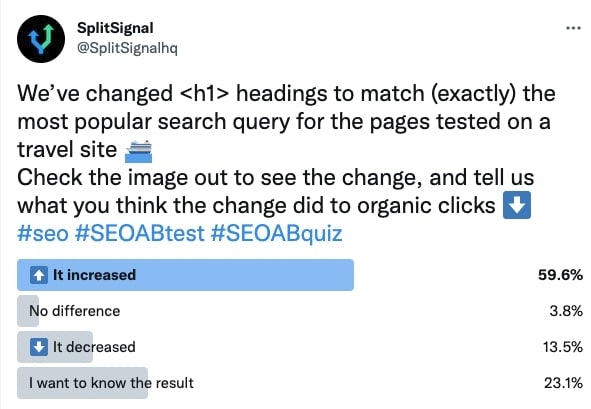
Semrush noticed that Google was rewriting the <H1> heading on the page to rewrite the page title in the SERPs.
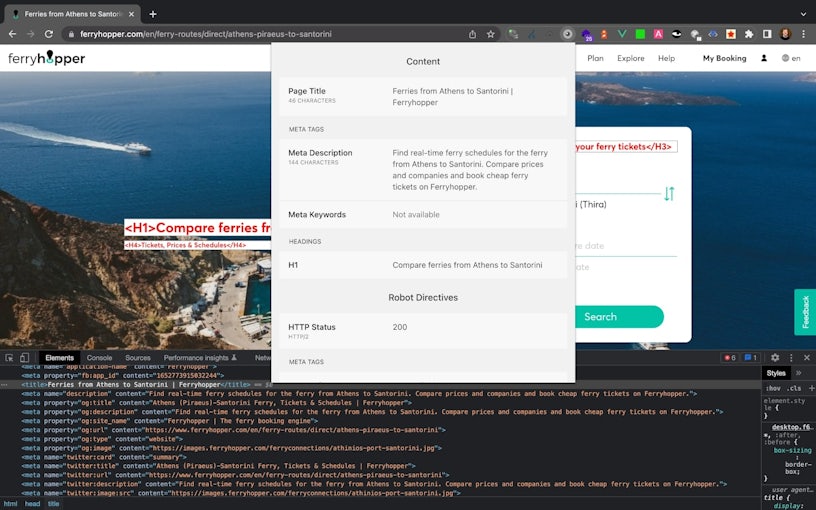
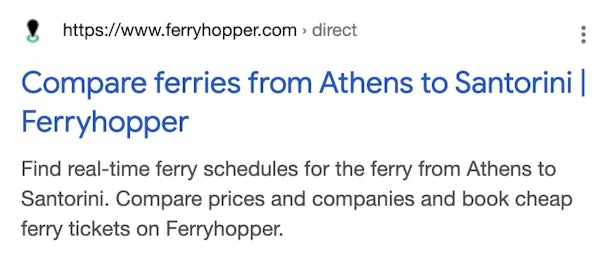
The main search term was “ferry from Athens to Santorini” or “ferry from Jersey to France”; people did not use “compare” in searches. The page title began with the primary keyword when the analysis showed the highest-ranking results. The use of “compare” may make a strong CTA – but the title that their client suggested would align better with the search intent.
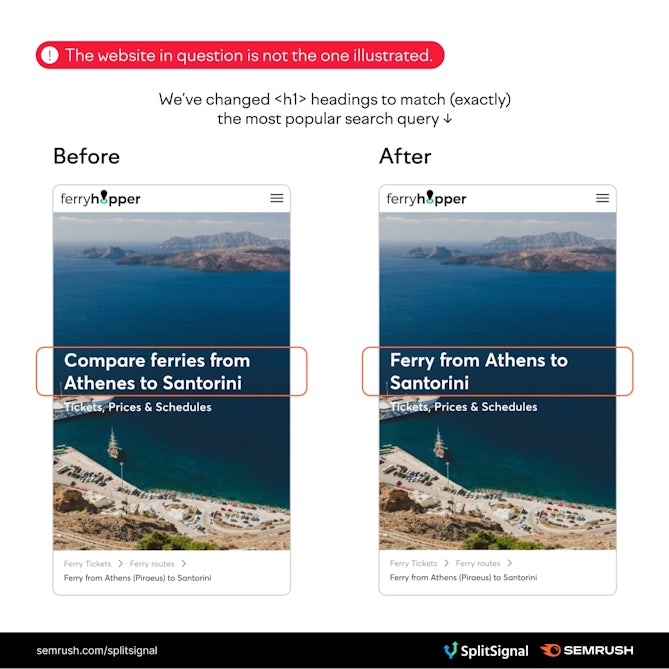
The test
Using SplitSignal to make the <H1> change for the tested pages. In total, about 200 listing pages were selected as either variant. Semrush started the test and ran it for 30 days, finding that Googlebot visited 92% of the pages tested.
The findings

After 30 days of testing, Semrush found that the traffic to the tested pages performed better than the control group, which means the test is positive and statistically significant at the 95% level. Matching the <H1> heading with the page title resulted in a 12% increase in organic clicks to the tested pages.
Why is this important?
This case study shows that it is important not only to be aware when Google rewrites your page titles but also to test whether Google is actually showing a better-performing page title.
With the H1 heading change, they found:
- The data shows that the test affected the click-through rate of the pages that were tested.
- Semrush saw a boost in clicks and impressions, indicating that the pages that were ranked the best became more relevant to search queries for which the pages were ranked.
- The H1 change and page title that appeared in the SERPs more closely matched the user’s search intent were some of the factors that led to the success of this test.
Keep up-to-date with our dedicated algorithm and search industry round-ups. For any further information about these posts – or to learn how we can support your SEO – get in touch today.



